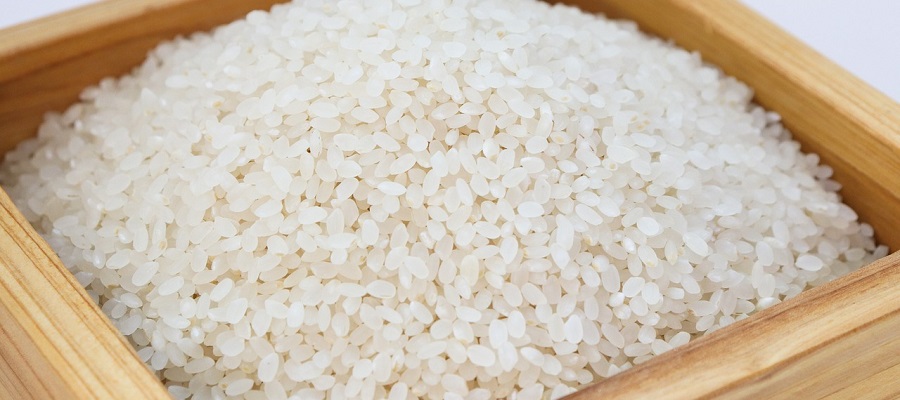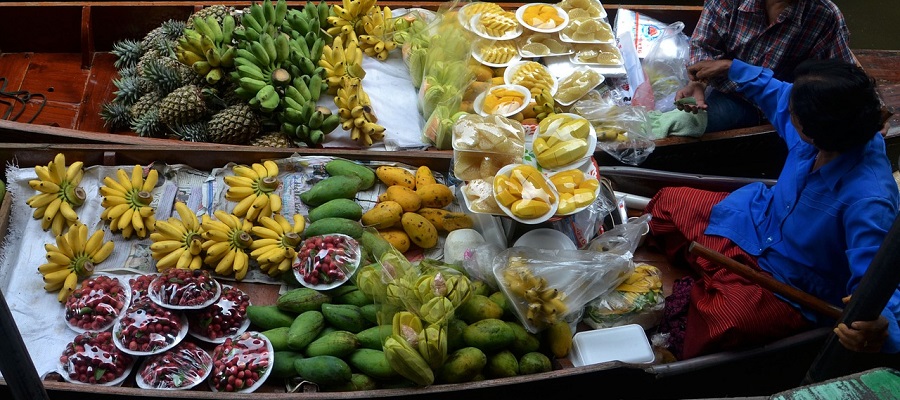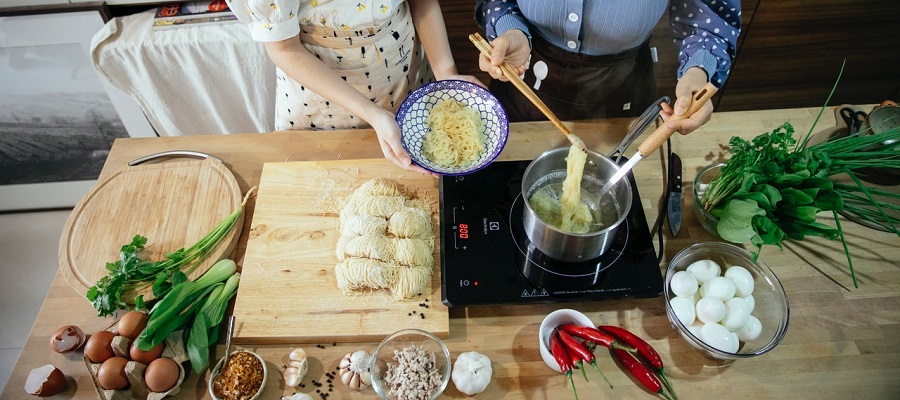Rice is rice? No, it's not. Because rice is not just rice, it is more diverse than some might think. Not only in the preparation for various dishes, whether as a salad, as a side dish for poultry and fish dishes or as a dessert. The varieties of rice differ greatly in taste. They offer variety and flavors of distant countries.
Rice is one of the seven most important cereals and one of the most species-rich staple foods. The power grain originates from tropical Southeast Asia. The degree of processing partly determines the subdivision into different varieties. But the grain length is also decisive. We introduce you to the different rice varieties.
Long grain rice
Long-grain rice is the name given to all elongated varieties whose grain has a length of 6-8 mm. Long-grain rice is hard and glassy; when cooked, it remains dry and grainy. These include basmati, jasmine rice, and parboiled rice, in which the ingredients from the skin are pressed into the grain with high pressure before polishing. This method preserves more ingredients than conventionally treated white rice. Basmati rice comes exclusively from certain cultivation regions at the foot of the Himalayas. When cooked, it releases a delicate fragrance and is an excellent accompaniment to Asian dishes. Jasmine rice is a fragrant rice that is mainly grown in the north of Thailand. However, it can also be found in Laos, Vietnam and even Italy. When cooked, it becomes slightly sticky and has a floral fragrance. The grains are comparatively small.
- Basmati rice: Basmati means "fragrant" in Hindi, which refers to its aromatic flavor. Basmati rice originates from Afghanistan and is grown at the foot of the Himalayas. Varieties include Kernel Basmati (Pakistan) or Haryana (India). Basmati rice is a great accompaniment to almost any dish. There is even a "Code of Practice on Basmati" for basmati rice. Basmati receives this seal if it is at least 6.5 mm long and contains a maximum of 7 percent foreign rice.
- Patna rice: Originates from the Indian city of Patna and is characterized by a comparatively hard grain. It is very suitable for dishes in which the rice should have a particularly grainy consistency. The grain is very long, thin and almost translucent due to polishing, but unfortunately also relatively low in nutrients.
- Jasmine rice: Is called fragrant or Siamese rice and is grown primarily in Thailand, but also in Vietnam and Italy. It has a pleasant jasmine scent and, unlike many other varieties, has a flavor of its own. Although it is a long grain rice, it is slightly sticky. It goes well with all dishes. Because of its sticky properties and because of its origin, it is often used in Thai cuisine.
- Black brown rice: This long grain rice is a whole grain rice. It is said to have once been reserved for the Chinese emperor, but is now also grown in Italy. Even in Burgenland, Austria, a black rice variety is cultivated. Black rice has a nutty flavor.
- Sadri: Sadri rice, which originates from Iran, is considered the best rice in the world. The Gilan region in the north of Iran on the Caspian Sea is the main cultivation area. Sadri consists of short strong grains that shine white. Nevertheless, Sadri belongs to the long-grain rice varieties. Its grains develop a soft, very creamy kernel during preparation and are characterized by an excellent aroma. Sadri is subject to strict export conditions, which makes it difficult to obtain. However, there are selected (online) stores that offer sadri.
- The parboiling process: "partially boiling" means partially cooking - was developed at the beginning of the 20th century. In this process, raw rice is first briefly soaked in water and then treated with hot steam. During this process, the water-soluble ingredients (including vitamins and minerals) unfold in the outer layers and partially penetrate the inside of the endosperm. The rice is then further processed, i.e. dried, hulled and polished.
- Parboiled rice is often advertised as containing up to 80 percent of the vital substances of natural rice. The fact is, however, that the loss is usually significantly higher, depending on the particular parboiled process and the particular vital substance.
- Parboiled rice may therefore be a little healthier than white rice, but it cannot compete with brown rice. This is because only the whole rice kernel provides nearly 100 percent of all the healthy vital substances and also contains the valuable dietary fiber of rice. A table with the vital substance values of parboiled rice in comparison with brown rice and white rice can be found in the main rice text already linked above.
- White rice: In the case of white rice, the silver skin and the germ have been removed by milling. However, the milled rice is very rough and releases a lot of starch into the cooking water, which is why it becomes very sticky during cooking. For this reason, it is polished - usually by rubbing the rice grains against each other - and thus smoothed.
- White rice has only one advantage over brown rice: it has a longer shelf life. In return, however, it loses a very large proportion of the minerals and vitamins it previously contained. In addition, since nowadays there is hardly any need for a food that can be kept for many years, even this characteristic is no longer an argument in favor of white rice. Whole grain rice can be kept for a good year, which is usually long enough.
Round grain rice
Round-grain and medium-grain rice are rice varieties whose grain is noticeably shorter than that of long-grain rice. Most of the round grain rice varieties are characterized by a higher starch content, the shape is oval to roundish and slightly transparent. When cooked, it becomes soft and also sticky due to the high starch content, making it the perfect base for rice pudding or sushi. The best known varieties include sushi rice, paella rice and risotto rice. The best-known risotto rice is arborio, which becomes creamy on the outside when cooked but remains firm to the bite on the inside. It takes its name from its origin, the Piedmontese town of Arborio, where it is grown.
- Risotto rice: To give a risotto its typical creamy consistency without losing its bite, Italian starchy rice varieties are in demand, such as Arborio, Vialone or Carnaroli. Risotto rice can be a round grain or medium grain rice. It is still grown mainly in Italy.
- Rice pudding: Rice pudding is a round grain rice and - as the name suggests - is mainly used for (sweet) milk dishes. For this purpose, it is cooked directly in the milk. The starch dissolves in the milk and the milk thickens. Cooked rice pudding has a pulpy consistency.
- Sushi rice: Originates from Japan and is called Kome there. It is small-grained and particularly starchy, which gives it the sticky consistency required for sushi. It is used not only for sushi, but also for other rice dishes. Sushi rice has a sweet aroma of its own.
- Paella rice: The so-called Bomba rice is grown especially in Valencia and Murcia and is traditionally used for paella. It has a lower starch content than other round-grain rice varieties and thus remains firmer and grainier when cooked. Paella rice is also available as medium grain rice.
- Glutinous rice: Used mainly for sweet rice dishes (e.g. rice pudding). It strongly releases its starch when cooked, making it very soft and losing its grainy form.
- Red brown rice: There are six known forms of this rice specialty. For example, Philippine red mountain rice, which is cultivated in the mountains above the jungle and is particularly rich in nutrients. The rice grains are colored red on the outside and inside. Camargue rice is grown in France and elsewhere, and the red outer skin is due to cultivation on clayey soil. Red rice should not be confused with "red fermented rice". This is where Google searches can cause confusion. Red fermented rice (also known as red mold rice) is a special dietary supplement advertised to lower cholesterol.
- Mochi: Mochi is a Japanese medium grain rice with a sweet aroma. It is sticky and mainly used for sweet rice dishes and rice cakes. Today it is also grown in the USA.
Brown rice
Brown rice is natural rice: its husk, the so-called silver skin, is not milled off. Thus, all valuable ingredients are preserved, which makes this rice variety particularly healthy. It is grown in various parts of the world: in Thailand and India, but also in Italy and the USA. It takes almost twice as long to cook and tastes slightly nutty. It is especially great as a side dish with fish, grilled meats or fruity curries.
Wild rice
Strictly speaking, dark wild rice is not one of the true rice varieties. Although the plants are related to each other, botanically speaking, wild rice is a water grass - and not a rice plant. The water grass is mainly found at the edge of lakes in Canada and the northern states of the USA. Unlike normal rice, wild rice is not cultivated, but grows naturally. It also provides more protein, potassium and magnesium. Grainy wild rice is characterized by its nutty and aromatic flavor. It is often offered mixed with other types of rice. On the plate, it definitely makes a visual impact due to its dark grains and offers itself as a great eye-catcher to meat dishes.
Green rice
Green rice is also referred to by some as Aplati rice. This is not actually a special type of rice, but rather a rice that has been harvested unripe. This results in different properties, because the conversion of sugar into starch has not yet taken place. For this reason, the rice also tastes a little sweet.
Green rice comes mainly from Vietnam and Thailand. In the case of Vietnamese aplati rice, the farmer squeezes the still unripe grains from the panicles. He then dries the grains in the sun. In order to bring out the green color, the farmers additionally dye the rice. The Thai Aplati rice is soaked in water by the rice farmer after harvesting. It is then flattened by special machines.
Due to the fact that the rice grains are treated a little rough, they are often an irregular and crushed.
Use of green rice
In green rice, the conversion of sugar into starch has not yet taken place, so it is wonderful for making porridge. Asian cooks use it especially often for breading poultry or fish. In Vietnam, shrimps are often garnished with Aplati rice. Due to its slightly sweet taste, the rice is also well suited for desserts. For example, Aplati rice can be used together with sugar to make a croquant.
Health aspects of green rice
Unlike conventional rice varieties, the starch content is lower in favor of sugar. For the connoisseur, this means that unlike basmati rice, for example, the rice is digested more easily and releases energy reserves more quickly. Sugar is not as complex in structure as starch, so the nutrient can be broken down into its constituent parts more easily.
Particularly noteworthy is the content of potassium. This mineral lowers high blood pressure and, together with the element sodium, which is also present, influences water balance. Potassium is also the central mineral in the transmission of nerve impulses.
Those who are daily afflicted by stress need an extra portion of magnesium. This mineral is also present in green rice. Magnesium helps with muscle cramps and protects the heart.
Aplati rice also contains the trace element iron. This is important for blood formation and for the supply of oxygen. Iron is the most important element of the red blood pigment hemoglobin.
Among the many vitamins, we should mention only the large amount of vitamin A, which is very important for the vision of the eyes.
Buy green rice online cheap
If you are planning your next vacation in Vietnam, you can buy green rice on any street corner. There they are wrapped in lotus leaves so that they take its delicate flavor. In Germany, the rice is still hardly known. Who knows an Asia store in the proximity, which can try there its luck. The customer can find it more quickly on the Internet. A popular store where the prospective customer can buy green rice is Amazon.


